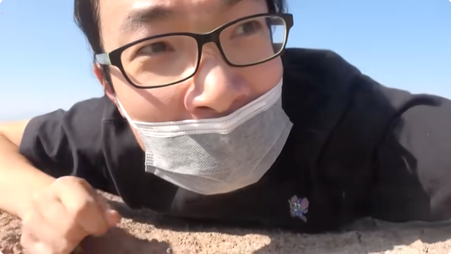Atlanta-based journalist Mario Guevara has been detained for nearly 100 days and is facing imminent deportation from the United States. His crime? Doing his job.
Guevara was detained first by local police and then by Immigration and Customs Enforcement, in what experts say was retaliation for his reporting on immigration raids and subsequent protests.
Guevara’s case is a disturbing example of how ICE can target non-American journalists, with or without legal status. Recently, Freedom of the Press Foundation (FPF) hosted a panel discussion featuring immigration lawyers, civil rights advocates, and journalists to talk about what to do when a journalist is detained by ICE — and what must happen before that day ever comes.
Here’s what we learned.
Why are journalists being detained?
Non-American journalists in the United States—especially those covering immigration or working in vulnerable roles like freelancers or independent journalists—are at serious risk as a result of the Trump administration’s anti-immigrant and anti-press policies.
President Donald Trump’s campaign to retaliate against journalists who contradict the government’s preferred narrative, plus his administration’s promise to ramp up deportations, has created a “perfect storm for those, like immigrant reporters, who are on the front lines,” said Nora Benavidez of Free Press.
“This administration has made it very clear that it considers the public and press documenting immigration enforcement to be a threat,” explained American Civil Liberties Union’s Scarlet Kim, who is part of Guevara’s legal team.
What can be done? Advanced preparation is key.
The experts we spoke to agreed: Newsrooms can’t wait until a journalist is detained to act. Here are key steps newsrooms and reporters can take before it happens.
1. Create an action plan before you need it.
Journalist and Investigative Reporters and Editors board member Alejandra Cancino has been working with fellow reporters to create a checklist to help newsrooms prepare for the potential detention of one of their reporters by ICE.
The checklist includes steps like gathering key information ahead of time, such as about medical needs, emergency contacts, and immigration attorney contacts (more on that below).
Cancino also encouraged newsrooms to talk with non-American reporters about their concerns and how to mitigate them. “We obviously don’t want any reporter to be taken away from their beat,” she explained, but creative risk-mitigation measures can work, such as having a journalist facing heightened risks report from the newsroom based on information being provided from others in the field.
2. Get local immigration counsel — now.
Journalists at risk need an experienced immigration lawyer in place before they’re detained, experts said.
Newsrooms should consider keeping local immigration counsel on retainer. “Getting a roster of vetted attorneys together is the first important step,” explained Marium Uddin, legal director of the Muslim Legal Fund of America and a former immigration judge.
News outlets should also consider having non-American journalists they work with sign a retainer agreement with an immigration attorney in advance, paid for by the newsroom, so that representation of the journalist could be immediate if they were detained, Uddin said.
To build their rosters of immigration attorneys, newsroom lawyers should seek referrals from those in their networks who may already have strong reputations and experience with the local immigration courts. They can also seek referrals by contacting organizations like the American Immigration Lawyers Association, the Immigration Advocates Network, and local legal aid offices.
Unfortunately, asylum cases can be expensive to litigate. In Texas, where Uddin is based, they can cost $10,000 to $20,000. While some immigration attorneys may offer free or low-cost services, newsrooms should budget for the cost of legal defense of non-American journalists detained by immigration authorities. Protecting journalists “is the cost of doing business,” said Cancino.
3. Act immediately to locate the detained journalist.
If a journalist is detained, one of the first steps will be to locate them, a process that can be made difficult by an opaque detention system and strategic shuffling of people around detention facilities.
Newsrooms should first determine if a detained journalist is in local custody, said Samantha Hamilton of the Atlanta Community Press Collective and Asian Americans Advancing Justice-Atlanta, since people who are arrested are often taken first to the county jail before being transferred to ICE.
If they have been transferred to ICE, Hamilton recommended searching for them with the online ICE detainee locator, using the person’s alien registration number and country of birth. If you don’t have that information, you can also search using their last name and country of origin. Hamilton recommended using all variations of the name, especially if the person has multiple names or uses a nickname.
Once a newsroom locates the journalist, it will want to figure out how to contact them. Each facility can have different communication rules, explained Uddin, which can often be found on the facility’s official website or ICE’s general detention center directory. Legal visits may require special steps, like completing a legal notice of representation.
4. Consider all the legal options.
In addition to challenging the journalist’s detention and deportation in immigration court, a legal petition known as habeas corpus may present another way to challenge the detention in court if a journalist is detained in retaliation for their reporting, said ACLU attorney Kim. A habeas petition asks a federal judge for an order that a person in custody be brought before the court to determine if their detention is valid.
A successful habeas petition can free someone from immigration detention. However, it cannot resolve their immigration status or stop deportation proceedings altogether. Those legal issues must be addressed separately in immigration court.
Habeas is especially important in cases where immigration detention is being used to punish people for their speech or journalism. The ACLU has brought habeas petitions in Guevara’s case and also to challenge the detention of students by immigration officials based on their political speech.
One of the biggest challenges in bringing a habeas petition is timing. Kim warned that strategic transfers of detainees between ICE facilities without warning can make legal action harder, because petitions must usually be filed in the jurisdiction where the detainee is being held. That’s why it’s so important to have legal counsel lined up and to file a habeas petition as soon as possible, ideally before any transfer occurs.
The bigger picture
A recent court ruling in California reminded the public that “a camera and a notepad are not threats to the public,” said Uddin. Unfortunately, however, government retaliation against non-American journalists remains a real threat.
So it’s not enough for newsrooms and journalists to prepare. People outside the media industry need to see how detentions of non-American journalists and other attacks on the press impact us all and speak up against them, explained Benavidez. “Because if it is one of those other people today,” she said, “it could be one of us tomorrow.”





